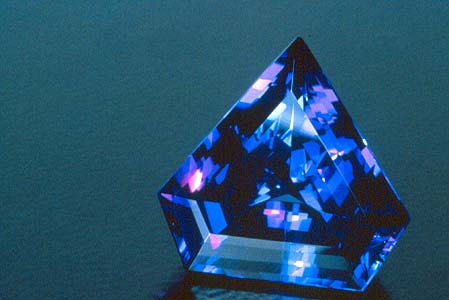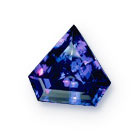 FREE SHIPPING on US orders over $150. Need help? Contact Us
FREE SHIPPING on US orders over $150. Need help? Contact Us Genuine Tanzanite Gemstone

Tanzanite (Pronunciation: \'tan-zə-,nīt\)
Tanzanite is a very special and unique gemstone. World-wide it occurs only in one specific location. Its blue colour which shimmers in a slightly purplish hue is magnificent indeed. Because of its unusually attractive flair it was easy for New York Jeweller Tiffany’s to make it one of the most sought-after and popular gemstones in the world.
Its name reminds of the world-wide unique occurrence in the east-African state of Tanzania. Africa – the name of this continent does not immediately remind us of gemstones. Nevertheless, Africa is a continent from where many splendid and beautiful stones find their way to the world markets. An example for this is Tanzanite, which was enthusiastically celebrated after its discovery in 1967 as "Gemstone of the 20th Century” The gemstone experts literally held their breaths when they were shown the first deep blue crystals mined in the Merelani Hi lls near Arusha in the north of Tanzania. Millions of years ago, metamorphous slates, gneiss stone and quarzites shaped impressive flat insular mountains on the wide planes near Mount Kilimanjaro. In the core of these unusual rises there are stored the valuable crystals. For a long time they remained hidden for the eyes of men, until one day some Massai-herdsmen passing by noticed crystals sparkling in the sun and picked them up.
lls near Arusha in the north of Tanzania. Millions of years ago, metamorphous slates, gneiss stone and quarzites shaped impressive flat insular mountains on the wide planes near Mount Kilimanjaro. In the core of these unusual rises there are stored the valuable crystals. For a long time they remained hidden for the eyes of men, until one day some Massai-herdsmen passing by noticed crystals sparkling in the sun and picked them up.
Today at Merelani the popular crystals are searched for in several, usually smaller mines, to some extent by means of modern methods. Generally only smaller grains are being found, but now and then the miners strike a lucky vein and produce a larger crystal – much to the pleasure of the mine-owners and the numerous Tanzanite enthusiasts everywhere in the world.
The Tanzanite trade is managed by many, usually small-scale licensed traders who have built up good business relationships with gemstone firms in Germany, India, Israel and the USA. An estimated 90 per cent of all Tanzanite traders are registered members of the International Colored Stone Association ICA and thus dedicated to the respective high ethical standards of ICA. In this way, then this exclusive gemstone is not brought to the world markets via suspicious back-street dealers, but in spite of its rarity is distributed via reliable and trustworthy official channels to well-reputed gemstone-cutters, and then passed on to the most important jewellers all over the world.
Actually only a blue Zoisite ...
Tanzanite is in fact the blue variety of Zoisite gemstone. However, the hydrated calcium aluminium silicate mineral achieves only hardness 6.5 to 7 on the Moh’s scale, and is thus not very resistant. Therefore it should be worn with care, never be cleaned by ultrasonic method and never come into contact with acids.
When New York Jeweller Company Tiffany was presented with the first Tanzanites right after they had been discovered, they were immediately convinced: this gemstone is a sensation! However, they recommended finding a new name for the blue beauty, since the gemmologically correct denomination "blue Zoisite" reminded unfortunately of the word "suicide". So Tiffany's suggested the name Tanzanite instead, derived from the place of occurrence, and the new name quickly became established on the market. And it was in fact the firm of Tiffany’s who introduced the stone to the public in a spectacular promotional campaign two years after it had been discovered.
... but what a spectacular colour!
Spectacular and magnificent is the deep blue of Tanzanite, ranging from ultramarine to a light purplish blue. The most coveted colour is a blue which shows a purplish hue shimmering around it, which is extremely spectacular in sizes above ten carats. Typical for Tanzanite is the appearance of several colours in one and the same stone: depending on the perspective, the stone appears blue, purple, or dun yellow. Most rough crystals, however, show a disturbingly large proportion of brownish-yellow, but the cutter may cure this by carefully heating the stone in an oven to about 500°C. In the course of this heating , utmost concentration is demanded, for it is essential to determine the moment when the colour turns blue. Heating is therefore a treatment which is generally accepted in the trade, however, the rough stone has to be as free of inclusions as possible, as otherwise the process will lead to fissures in the stone.
Working with Tanzanites is a task which will cause even experienced cutters to tread carefully, as the cleavage of the gemstone is very high in one direction. The exclusive stone is cut in any imaginable shapes and forms, from classical round cuts to imaginative designer cuts.
Tanzanite is always fascinating because of its unusual appeal that will hold everybody in its thrall. The deep blue with the slight purple shade is one of the most extravagant colours available. It symbolises immaculate but unusual elegance. Whoever purchases such a unique gemstone wants to be set apart from the masses. Wearing it communicates self-confidence and individuality. The almost magical colour of a perfectly cut Tanzanite is not only attractive on young women, it also emphasises the individuality of a mature woman.
For Tanzanites in especially good qualities and larger sizes almost any price will be paid by now. What is it that makes this stone so coveted? Is it only the spectacular colour? Well, it seems we must also take the exclusive origin into account here. As the stone is found on one special location only in all the world, it is especially valuable. After all, the desire to own something unique and rare has always been a decisive criterion for assessing the value of special gemstones.



